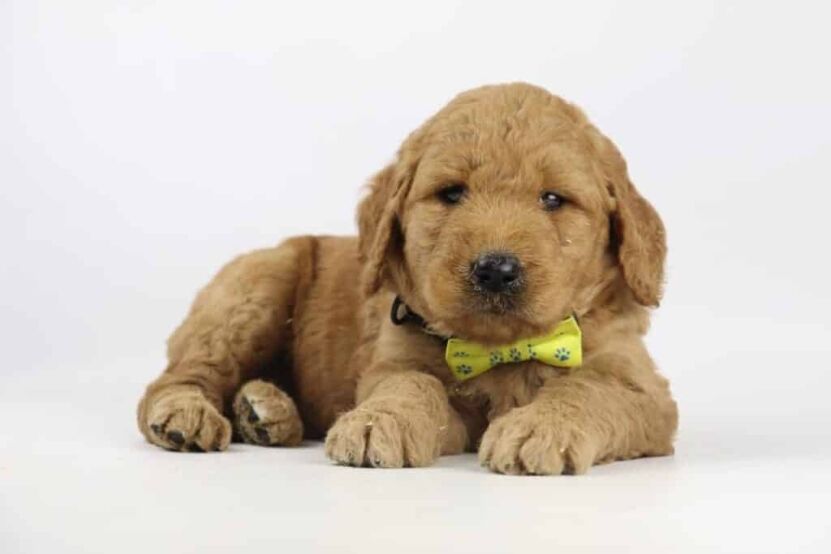As the name suggests, this is a cross between a Golden Retriever and a Poodle, so you get a Goldendoodle F1. The aim of these breeders was to train guide dogs for blind and visually impaired people, because of the little or no shedding. Today, the Goldendoodle is a family dog. This dog is great for families with children, even if there is someone with an allergy. The big advantage of the Goldendoodle is that this dog hardly sheds because the fur comes more from the poodle. This also makes people less likely to suffer from allergies.

Properties of a Goldendoodle
The Goldendoodle is known as a hypoallergenic breed. This means that we see reduced allergic reactions in allergic people, so fewer symptoms. A reduction of up to 95% is claimed. This breed would be a godsend for people who want a dog but suffer from asthma, CARA, or people who are sensitive to allergens. People with allergies are advised to spend time with these dogs before purchasing one and to continue taking their meds.
This breed is not at all non-allergenic, allergen-free dogs do not exist, even hairless dogs are not non-allergenic. This is because allergic reactions are mainly triggered by dander and not usually by length or the amount of hair on the coat. Hair does play a role in allergies because pollen, dust and mold can get stuck in the hair. People can also have an allergic reaction to the saliva.
In addition, these dogs can be very suitable as assistance dogs, both for people with a visual or other handicap and for people with emotional or behavioral problems. Goldendoodles can also be used as assistance dogs for children with ASD (the entire spectrum of autistic disorders), with ADHD, or with problems with bereavement. Nowadays, the Goldendoodles are also trained for (former) soldiers from war zones and suffer from PTSD (Post Traumatic Stress Syndrome).
The characteristics of a dog breed determine the degree of suitability of this breed for its owner. This is related to the owner’s lifestyle and family composition, the amount of time and energy an owner has available for his or her dog, and the expectations the owner has of his or her dog. A good match must be present to make both parties happy.
The most characteristic features of the Goldendoodle are the following:
• An exceptionally high intuitive ability:
These dogs feel emotions very well, they seek eye contact and try to cheer or comfort you. They are also very intelligent and easy to train. That is why they are ideally suited as a therapy dog, assistance dog or (blind) guide dog. They enjoy being around people, love children, and are therefore good family dogs. (this must be included in the socialization because every dog
The downside of this trait is that keeping this type of dog requires a lot of time and attention. The most cruel thing you can do to this type of dog is to leave it to its own devices. Their cleverness also ensures that they learn undesirable as well as desirable behaviors just as easily, so training is essential. These dogs quickly outsmart their owners. If you are not willing to invest in puppy training for the first 12 months, you should choose another breed.
• Hypoallergenic breed:
Because these dogs have hair that is so close together that there is almost no place for dander and because they do not shed much, they are known to be allergy-friendly and not asthma-inducing. Another advantage of their coat type is that they do not smell. The flip side of this trait is the care you need to take to grooming during the transition from puppy to adulthood.
Between the ages of 10 to 14 or 15 months old, the puppy coat changes to the adult hair type, even now this hair does not fall out. This means that simply brushing the coat during this period is not sufficient, but that you have to work with professional trimmer materials to remove dead hair. If you do not do this, the fur will become mats and felt, and you will eventually have to shave the dog bald (which happens to many people).
• Crazy about water: When
these dogs see water and want to jump in it. As soon as they get the chance to play with water anywhere, they will. This means that they love to play with their water bowl, dive under garden sprinklers and dart around in mud puddles, they also jump in the sea, nice to follow the seagulls.
• Dogs with humor:
They are dogs with a tendency to act crazy, to make you laugh or get your attention. When you ignore them for too long or don’t have the time or attention for them, they get rowdy and may start dragging objects because they want to play. That’s not a bad thing, but it can be an annoying feature for some people.
Read our reviews on: https://www.woefkesranch.be/reviews/